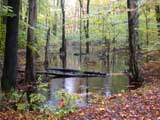- Home
- About S&T
- Taxa/Organisms
- Ecosystems
- Issues
- Methods & Tools
- Reports & Publications
- Location
- Search
Publisher: USGS | Science Center: Columbia Environmental Research Center (CERC, Columbia) | Format: URL
www.cerc.usgs.gov — The BFRS works cooperatively with team members from CERC and with faculty and graduate students of Department of Wildlife and Fisheries Sciences at Texas A&M University in research areas represented by the branch structure of the CERC including toxicology, ecology, biochemistry and physiology, environmental chemistry, ecogeography, and information More...

Publisher: USGS | Science Center: Patuxent Wildlife Research Center (PWRC, Laurel) | Format: URL
www.pwrc.usgs.gov — The NAAMP is a collaborative effort among regional partners, such as state natural resource agencies and nonprofit organizations, and the U.S. Geological Survey (USGS) to monitor populations of vocal amphibians. The USGS provides central coordination and database management. The regional partners recruit and train volunteer observers to collect More...

Publisher: USGS | Science Center: Columbia Environmental Research Center (CERC, Columbia) | Format: URL
www.cerc.usgs.gov — The ultraviolet radiation (UV) component of sunlight can pose a direct threat to aquatic flora and fauna. This issue overview describes the interactive effects of ultraviolet radiation on vertebrate and invertebrate organisms from freshwater and coastal habitats, and interactive effects of ultraviolet radiation on vertebrate and invertebrate More...

Publisher: NBII | Format: URL
frogweb.nbii.gov — A web resource for research in amphibian declines phenomena, habitat loss, climate change by exposure to UV radiation, contaminants and pollutants, disease, and predation by invasive species. General resources relating to declines phenomena and monitoring tools and resources are available on this webpage.

Publisher: USGS | Science Center: Western Ecological Research Center (WERC, Sacramento) | Format: URL
www.werc.usgs.gov — Once an abundant frog throughout much of central and southern California, the California red-legged frog (Rana draytonii) is now rare in the Sierra Nevada foothills and the southern portion of its range. In parts of the central Coast Range, however, large, vigorous populations do remain. Most protection efforts for this threatened species have More...

Publisher: USGS | Science Center: Patuxent Wildlife Research Center (PWRC, Laurel) | Format: URL
www.pwrc.usgs.gov — Information about ecotoxicological exposure and its effects on terrestrial vertebrates residing in estuarine and coastal habitats like the Atlantic, Gulf and Pacific Coasts, Alaska and Hawaii, as well as the Great Lakes. These vertebrates include birds, mammals, amphibians and reptiles. The data is a compilation of results from computerized More...

Publisher: USGS | Science Center: Forest and Rangeland Ecosystem Science Center (FRESC, Corvallis) | Format: URL
fresc.usgs.gov — The National Park Service has stated that declining amphibian populations are the top priority for research in the National Park System. Salamanders are a native vertebrate predator in high-mountain lakes throughout the western US, especially in many small lakes naturally barren of fish. This issue overview demonstrates the potential for using More...

Publisher: USGS | Science Center: Forest and Rangeland Ecosystem Science Center (FRESC, Corvallis) | Format: URL
fresc.usgs.gov — Little is known about the amphibian taxa associated with streams, lakes, ponds, and wetlands in Mount Rainier National Park (MORA). This issue overview addresses the concerns about the possible impacts of introduced trout on amphibian taxa, and park management's interest in documenting current distribution and abundance of amphibian taxa in the More...

Publisher: USGS | Science Center: Forest and Rangeland Ecosystem Science Center (FRESC, Corvallis) | Format: URL
fresc.usgs.gov — Fish introductions have been implicated in the disappearance of amphibian communities and in the alteration of zooplankton communities. Furthermore, the presence and abundance of amphibian larvae and zooplankton in mountain lakes are directly related to nutrient concentrations in the aquatic environment, as well as enhancement to recreational More...

Publisher: USGS | Science Center: Forest and Rangeland Ecosystem Science Center (FRESC, Corvallis) | Format: URL
fresc.usgs.gov — Prescribed fire and forest thinning is a management strategy that promotes the development of forest structure and composition similar to that present under a native fire regime. This research summary describes how FRESC researchers will address the effects of prescribed fire and forest thinning on the diversity, abundance, and habitat More...

Publisher: USGS | Science Center: Western Ecological Research Center (WERC, Sacramento) | Format: URL
www.werc.usgs.gov — Native amphibian and reptile populations worldwide are under threat from exotic invasive species of plants and animals, including other reptiles and amphibians. As habitats are changed and plant community organization is modified by exotic species, delicate relationships between plants and animals are altered or eliminated, creating a negative More...

Publisher: USGS | Science Center: Patuxent Wildlife Research Center (PWRC, Laurel) | Format: URL
www.pwrc.usgs.gov — Amphibian Research and Monitoring Initiative (ARMI) is designed to determine where populations of amphibians are present, to monitor specific Apex populations, and to investigate potential causes of amphibian declines, diseases, and malformations. The Northeast Region of ARMI encompasses thirteen states (Connecticut, Delaware, Maine, Maryland, More...
